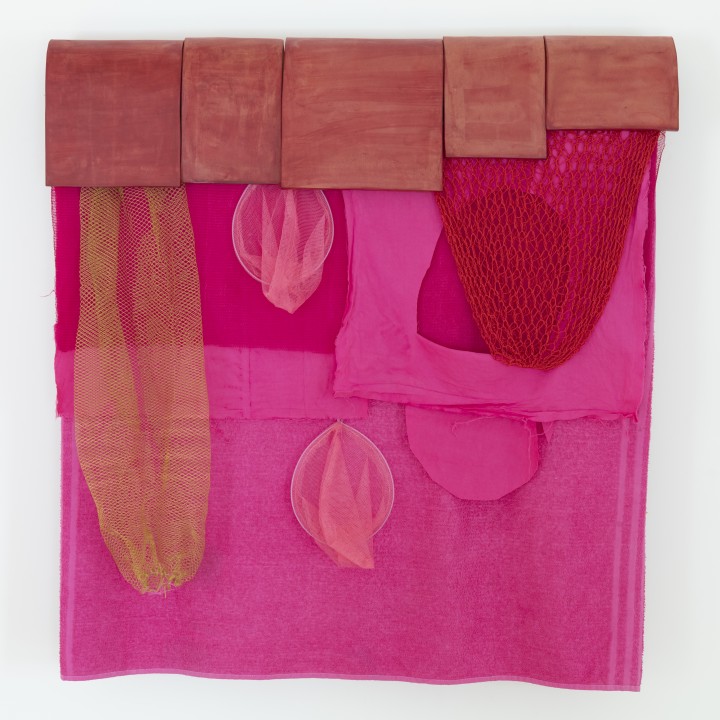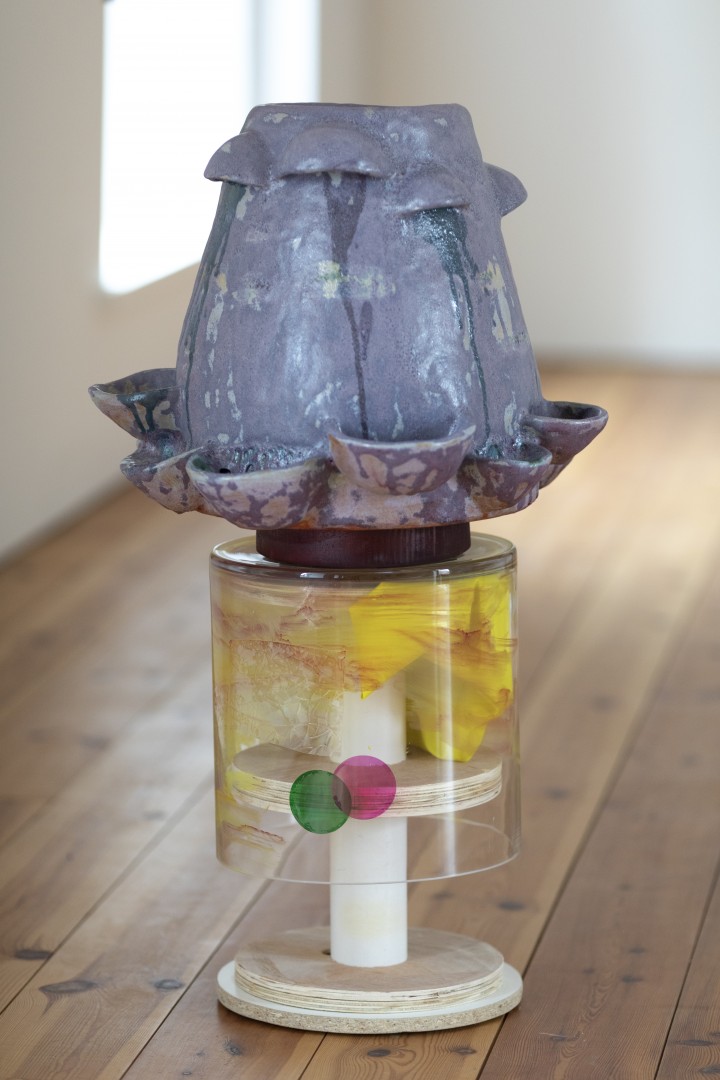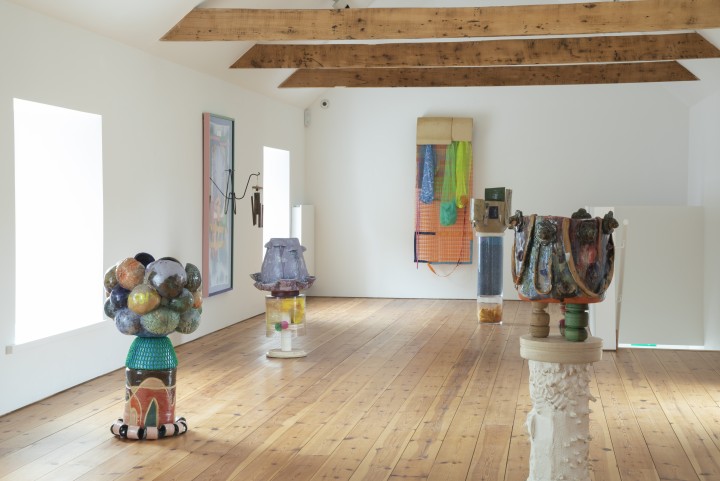Scottish Art News
Latest news
Magazine
News & Press
Publications
Laura Aldridge - sumVigour
By Susannah Thompson, 12.07.2021

In his 1994 book Baroque Baroque, Stephen Calloway claimed that the Baroque was the manifestation of the ‘perennial English conflict between Roundheads and Cavaliers, between minimalism and excess’ which was ‘fought yet again, but as a style war.’ Centuries later, in spite of a firmly established disavowal of Modernist myths of ornament as crime, works of contemporary art which dare to exude ‘too much’ tactile and visual pleasure are still viewed with suspicion, as though, by virtue of exuberant colour or decoration, something corrupt has turned art into mere style. These ideas are playfully revisited and thoroughly undermined in sumVigour, an exhibition of new work by Glasgow-based artist Laura Aldridge.
 Laura Aldridge, Things that soak you (XV), 2021, stoneware, dye, netting, fabric, towel, 124 x 112 x 18.5 cm. Image Mike Bolam, courtesy of the artist and CAMPLE LINE.
Laura Aldridge, Things that soak you (XV), 2021, stoneware, dye, netting, fabric, towel, 124 x 112 x 18.5 cm. Image Mike Bolam, courtesy of the artist and CAMPLE LINE.
Against the immaculate white walls and polished wooden floors of Cample Line, a spare, elegant barn conversion in the rural Dumfriesshire countryside, Aldridge’s sculptures appear almost incongruous in their flashy, fleshy, attention-seeking form. In contrast to their surroundings, Alridge’s work is more Morris Lapidus (‘too much is never enough’) than Mies van der Rohe. As its title suggests, sumVigour is a vigorous, joyous celebration of maximalism. Over the last fifteen years or so, the artist has worked across a broad range of disciplines and forms, including textiles, photography, found objects and glass, while her processes and methods of making have spanned printing, dyeing and casting. The combination of these media in her installations has been described by the artist as an expanded form of collage, evident in the idiosyncratic juxtaposition of materials, shapes and colours in works such as Handle/Relief or Things that soak you (XIV) (both 2021). As critic Oliver Basciano notes in the essay commissioned for the show, while Aldridge’s work is characterised by its haptic qualities, ‘there is a sensory schism here, the surface texture at odds with how one imagines the work to feel.’ But though they pay scant regard for the conventions of colour and composition, Aldridge’s handling and placement of the works in the space find a way to generate harmony between one another, and appear as a unified ‘whole’ work of art.
 Laura Aldridge, Handle/relief, 2021, glazed stoneware, wood, glass vase, rainbow filter, fabric, 89 x 50 cm. Image Mike Bolam, courtesy of the artist and CAMPLE LINE
Laura Aldridge, Handle/relief, 2021, glazed stoneware, wood, glass vase, rainbow filter, fabric, 89 x 50 cm. Image Mike Bolam, courtesy of the artist and CAMPLE LINE
Wall-based reliefs and sculptural assemblages such as Libretto-ah! or Comparing my insides to other people’s outsides (that’s your freedom) (both 2021), could be part of an absurdist stage set, populated by oversized, ambiguous props. Perhaps this is why, though dealing primarily with intuitive ways of making and undertaking an intensive, physical exploration of the material qualities of her works, Alridge’s artworks also have the capacity to suggest narrative. The use of wryly humorous titles and an allusive anthropomorphism that has long been present in the artist’s practice add to a desire of the part of the viewer to both touch and ‘read’ these works. In this respect, sumVigour might be seen as a kind of object theatre, in which everyday things are explored both for their intrinsic material properties and act as stand-ins for characters or symbols. As with object theatre, in this exhibition some works employ the whole space of the ‘stage’ while others are more discrete, static performances presented on handmade plinths. Human-size, some look as though they could come to life at any moment and dance across the floor of the gallery. The theatre director Kathy Foley noted that ‘because of the abstraction already implicit in the choice of an object as living/talking/performing, the genre invites the audience into non-literal thinking [and] metaphor, metonymy, humour, and poetic thinking are evoked’. The same, I think, is true here, where what appear, ostensibly, as a study in form and colour nevertheless generates a web of free associations on the part of the viewer.
 laura aldridge - cample line - june 2021_mbp_2328.jpg) Laura Aldridge, TEN, 2021, glazed stoneware, epoxy resin, 52 x 35.5 cm. Image Mike Bolam, courtesy of the artist and CAMPLE LINE.
Laura Aldridge, TEN, 2021, glazed stoneware, epoxy resin, 52 x 35.5 cm. Image Mike Bolam, courtesy of the artist and CAMPLE LINE.
Pre-eminent in sumVigour is Alridge’s use of ceramics, a material than has been a dominant element of her work over the last eight years or so, in common with many other contemporary artists in Scotland (including some of Alridge’s former collaborators such as James Rigler). It might seem fitting, then, that the show has been held at Cample Line, given that the Dumfriesshire countryside is so peppered with accomplished studio potteries such as those of Archie McCall, Andy Priestman, Claire Dawdry, Jason Shackleton, Fitch & McAndrew, Barnbarroch and many others. But while these makers produce largely traditional, highly skilled wares for discerning, tasteful collectors, Alridge’s work is more Minton & Co-meets-Memphis, a hybrid of traditional majolica ware and 1980s postmodern design. Indeed, works such as Enobled Objects (touch face, slip) (2021) could almost be an ‘expanded collage’ where a Victorian jardinière meets mid-80s Frank Bosco and Frank Stella. They’re a lot of fun: all ornament, decoration, pattern.
 Laura Aldridge, sumVigour [installation shot], 2021. Image Mike Bolam, courtesy of the artist and CAMPLE LINE.
Laura Aldridge, sumVigour [installation shot], 2021. Image Mike Bolam, courtesy of the artist and CAMPLE LINE.
Running in parallel with sumVigour, Alridge (with Leanne Ross and Judith Scott) has also presented work at Kendall Koppe as part of Glasgow International for The Outside is Inside Everything We Make. In both venues, the success of Alridge’s self-assured works are in no doubt. Post-lockdown, they are moving in their optimism and a testament to the artist’s embrace of ‘positive doubt’ in the process of making new work during the pandemic. But credit must also go to Cample Line’s curatorial team for their invisible labour in creating the ideal conditions for an engaging experience of the works. The gallery’s attention to detail is outstanding in its efforts to be open and accessible: the upper floor can be reached by a purpose-installed lift; audio descriptions of the work are available via QR codes; a revealing film of the artist discussing the works is part of the exhibition; local schools have made works in response to the show; a WiFi code and gallery maps are provided for visitors; and in the accompanying booklet an insightful contextual essay by Oliver Basciano further extends the capacity for visitors to reflect on this exhibition, both during and after their encounter with these remarkable works.
Laura Aldridge, sumVigour is showing at Cample Line, Dumfriesshire until the 29th August. Open Thurs-Sun, 11am-4pm by pre-booked appointment, plus a drop-in hour 1-2pm on those days (no booking required).




